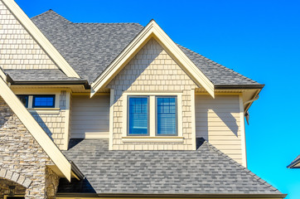Roofing Durham NC protects buildings from rain, snow, sunlight, and extreme temperatures. Roofing includes internal structures such as rafters and trusses and external structures such as eaves and fascia.
Metal panels can be formed onsite or prefabricated in factories. Some have hidden fasteners; others use a nail or fastener flange.

With the constant exposure of roofs to various environmental elements, the durability of roofing materials is one of the most important factors that homeowners consider during a home improvement project. However, not all roofs are built the same, and not all materials offer equal durability. The best option for your home will depend on the climate in which you live and your personal preference.
A metal roof, which can be made of steel, aluminum or other alloys, is a durable choice and can last up to 50 years. It can withstand high winds and other extreme weather conditions. Depending on the color and coating, a metal roof can also be extremely attractive.
Slate tiles are another very durable option, lasting a minimum of 50 years and often up to 100. They are most common in the Southwest on Spanish-style homes and can withstand high heat and humidity while reducing energy costs because they reflect sunlight instead of absorbing it. However, slate is expensive and heavy, so homeowners will need to consult a structural engineer to ensure their home can support this type of roof. Leaks can still occur even with a very durable roof, especially at penetrations such as chimneys and where roof planes meet. Replacing or fixing the flashing at these points can prevent leaks.
The roof is a crucial component of a home or commercial property, but it doesn’t have to be plain and boring. In fact, the roofing structure can play a major role in shaping the overall aesthetic of a building and how it connects with its surroundings.
A roof’s beauty can be a source of personal satisfaction for its homeowners and occupants. Moreover, it can also be an asset in raising the value of a house and attracting potential buyers.
In addition to traditional shingles and tiles, there is a wide array of other roofing materials expressly designed for visual impact. For instance, synthetic roofing materials can mimic the look of slate or wood for a more luxurious style. Other options, like green roofs and solar panels, offer a forward-thinking style that can also enhance energy efficiency.
It is important to choose a roofing color that harmonizes with the color of the siding or brick on a building. Otherwise, the roof can become a stark contrast that clashes with the structure’s design and color scheme.
Energy efficiency is an important aspect to consider when choosing a roof. The right roofing materials can help reduce a home’s energy costs and carbon footprint. Energy-efficient roofing also helps to prevent heat loss and air leaks.
A roof’s color and coatings are a big part of its energy efficiency. Choosing lighter colors, such as white, can help reflect the sun’s energy. This will keep the attic cooler and reduce the amount of heat that is transferred into living spaces below. Cooler attics and a reduced use of air conditioning can significantly reduce energy costs.
An energy-efficient roof can also reduce heating costs by retaining the warmth inside your home in winter. In the United States, it’s estimated that about half of a homeowner’s utility bill is spent on heating and cooling. An energy-efficient roof can significantly decrease these costs and produce an immediate return on investment.
Other ways to improve your home’s energy efficiency include insulating walls and installing programmable thermostats. Also, be sure to maintain proper ventilation in your attic. This will help to avoid heat accumulation and moisture buildup, which can lead to insulation damage. You may also be eligible for local rebates or credits for switching to an energy-efficient roof.
During storms, your roofing experiences a lot of stress. Winds during severe storms such as hurricanes or tornadoes can cause damage ranging from a few missing shingles to the entire roof being torn off. To reduce the damage, homeowners can take several steps before a storm hits. One of the first things they can do is clear away any debris that could become projectiles during high winds. Patio furniture, lawn ornaments, and tree branches are among the most common items that can fly off during a severe storm and cause significant damage.
Once the debris has been cleared, the next thing you can do is visually assess and document the damage. This will help you get your insurance claim process started if you think your roof has been damaged by the storm. Start by taking pictures or videos of the damage as soon as it is safe to do so. Be sure to look in all areas of the roof, including chimneys, vents, skylights and valleys.
Another important area to check is the surrounding soffits, fascia and gutters. These are designed to keep water and debris from entering the house, so if they suffer damage, it can lead to leaks in the interior of the home. Look for signs of damage such as dents, cracks and looseness around these areas.
Hail can also cause significant damage to a roof. Smaller hail can destroy crops and hurt farmers, while larger hail can dent or shatter the hoods of cars and glass in homes and businesses. To protect your roof from the damage caused by hail, you should use high-quality roofing materials that can withstand impacts from hail stones sized 0.2 inches to 1.75 inches in diameter.
Other types of roof damage that can occur during a storm include loose or broken shingles and damage to the underlayment. If a shingle is broken or loose, it can create an entry point for moisture and insects, which can lead to other problems like wood rot and mold. If you are concerned about the condition of your roof, contact a professional for a free property and drone inspection.